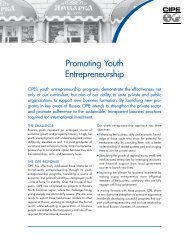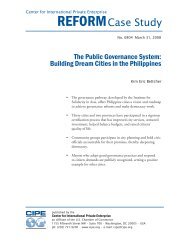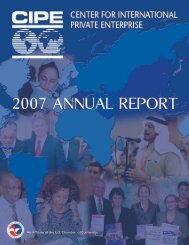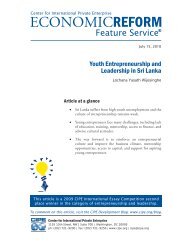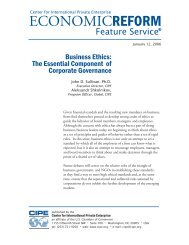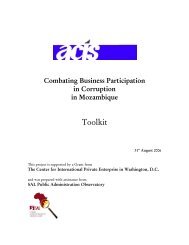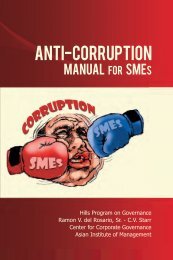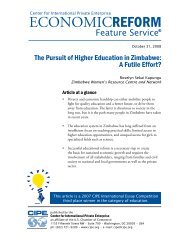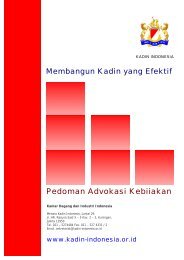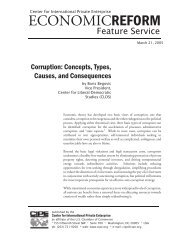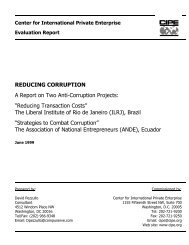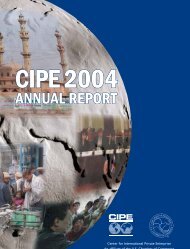Responsible Business Guide: A Toolkit for Winning Companies
Responsible Business Guide: A Toolkit for Winning Companies
Responsible Business Guide: A Toolkit for Winning Companies
Create successful ePaper yourself
Turn your PDF publications into a flip-book with our unique Google optimized e-Paper software.
RBG<br />
<strong>Responsible</strong> <strong>Business</strong> <strong>Guide</strong>: A <strong>Toolkit</strong> <strong>for</strong> <strong>Winning</strong> <strong>Companies</strong><br />
RBF Pillar 4: Stakeholder Involvement and Social Investment<br />
Talking to stakeholders and seeking their active involvement, from product feedback to<br />
social investments, is seen as a major benefit to business because such feedback and<br />
resulting empathy from clients as well as the community drive the success of a company’s<br />
strategic approach.<br />
Shareholders and Stakeholders<br />
Few people had heard of the term stakeholder in the business community not too long<br />
ago. When the term first appeared in its present context in the early 1980s, it was confined<br />
to academic debate on who really matters to a business. Not until the mid-90s did the<br />
stakeholder attain relative prominence within corporate circles, amid controversy driven<br />
by a well-in<strong>for</strong>med consumer society newly awakened to the exploitative tendencies<br />
exhibited by major companies.<br />
The shareholder has traditionally been at the center of business decision-making, because<br />
modern economic theory is rooted in profit maximization, which in turn creates an incentive<br />
<strong>for</strong> the shareholder to push <strong>for</strong> the most returns at the least cost. This desire of the<br />
shareholder has progressively altered the global business model, most significantly<br />
demonstrated by U.S. or European multinationals shifting manufacturing of their products<br />
to poorer countries where wages are much lower and implementation of work-place safety,<br />
human rights, and financial controls are quite weak.<br />
This remained a successful <strong>for</strong>mula <strong>for</strong> maximizing profits <strong>for</strong> the better part of the last<br />
century, propelling consumer goods companies, apparel and textile manufactures, footwear<br />
and fashion brands, all to create extensive global supply chains. However, in the 1990s,<br />
a succession of press exposés highlighted the poor treatment of workers producing goods<br />
<strong>for</strong> multinationals, often on duty beyond the working hours mandated by law, paid belowsubsistence<br />
wages, and in workplaces that an American or European worker would find<br />
unacceptable and the law would not allow.<br />
The 1990s mark the entry of the stakeholder into the corporate canvas. Perhaps the<br />
watershed was the story about Taiwanese managers mistreating local workers in Nike’s<br />
footwear factories in Vietnam, just as there were reports of children stitching Adidas<br />
footballs in Sialkot, Pakistan. In the wake of public outrage and community campaigns<br />
against the offending brands, there was a movement to monitor the behavior of multinational<br />
companies more closely in the developing world. Public campaigns such as the “Foul Ball<br />
Campaign” demanding the banning of footballs from Sialkot, or the “Global March Against<br />
Child Labor” demanding an end to the exploitation of underage workers resonated across<br />
the world. Stakeholder sentiments were reflected in shareholder value; in the aftermath<br />
of the Vietnam report, Nike’s share value fell significantly.<br />
<strong>Responsible</strong> <strong>Business</strong> Initiative 37



